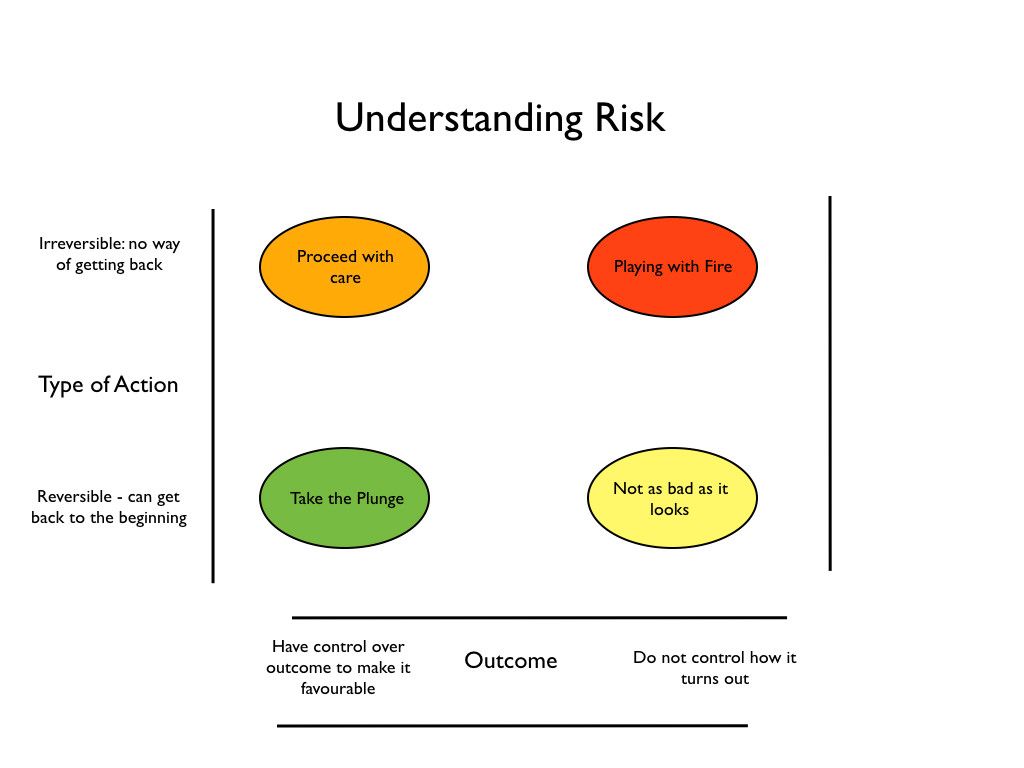
This short poem by young Australian poet Erin Hanson goes to the heart of any decision that is wrapped in uncertainty. It eloquently asks the questions - what do you have to lose, and what do you stand to gain - in the right order.
Should I take this job or launch a startup? Should I move to another city or stick around where I am comfortable? Should I buy or should I continue to rent? We constantly encounter decisions and questions from the mundane to the material. And the dilemma we find ourselves in, as we are about to take the plunge is the question - how risky is this move? I believe a better question to ask is, what do I stand to lose?
Risk is best understood as a combination of two factors - how reversible is the decision and how controllable the outcome.
If a decision is reversible, meaning you can roll back the changes to more or less arrive at the starting point, it is not risky. This applies to simple things like going on a vacation (you are back home with a slightly smaller bank balance but otherwise fine), and sometimes more complex decision such as buying a car (it can be sold, again, with some financial hit). Decisions such as buying homes are also reversible, if the property can be resold.
On the other hand, some decisions we make are not easily reversible - getting married (reversible in theory... but you get the idea), moving to a different geography from which a return is difficult (applies to moving across countries if you don't have the ability to return), or making a huge financial commitment from which getting out is difficult (say you are setting up a factory). And some are truly irreversible - serious medical procedures fall in this category.
The graphic below illustrates the possible scenarios:

Image Credit: Shripati Acharya, Co-Founder and Managing Partner at Priven Advisors, Advisory to Prime Venture Partners
Walking through the ovals - decisions, where you control how it will turn out, and which can be easily rolled back in case you change your mind, are in the 'no brainers', 'take the plunge,' category. When they can’t be rolled back easily, but the uncertainty is low - say buying a home in an illiquid market, where getting rid of the property is a long and painful process but you know the neighbourhood well so the move is unlikely to yield unpleasant surprises - requires a lot of thought. Hence, proceed with care.
Irreversible and uncontrollable outcomes are obviously risky.
Few decisions fall in this category, having a major medical procedure with little precedent or climbing Everest could qualify. When the decision is reversible, but yet the outcome is beyond your control, are the hard ones to judge. These appear risky on the surface yet on careful consideration, might be highly sensible.
So how should you think about a job change? The new job looks interesting, is better paying but you don’t know the people you are working with, and it’s a new domain. A common dilemma for the job hopping techie.
Since it’s a new domain in a new company, your performance at the job and consequently your job satisfaction will depend on factors that you don’t quite know before hand. There appear to be a large number of unknowns. In other words, you have little control over the outcome.
But how irreversible is this decision to take up a new job? Ask how hard it would be to get back to where you are today if the job doesn't work out. Easier if it doesn't require major re-location or getting into a completely different domain. Even a new domain is attractive if it is in a rapidly emerging area. Chances are high that you can access even more opportunities than before you began the new job. The move is also more easily 'reversed' if it's early in the career, which means the change is at a junior or mid level role. The same move is a lot less reversible if the career change involves a CEO moving from one company to another, since the number of roles at that level are fewer and open up infrequently.
Hence, job changes, especially early in the career, mostly fall in the ‘not as bad as it looks’ category (see graphic), and hesitating too much is overstating the risk.
However, if you are going to an area from where the industry is shrinking, you might be staring into a diminishing set of options if the job doesn’t work out. That carries a greater career risk. Such a career move is more irreversible in nature.

How can you make such a move less risky?
By striving to make a favourable result more likely - i.e., moving this risk from top right to the top left in the above graphic. In this case, knowing the company, the job, the people with whom you are going to work becomes critical. If these factors are known, culture fit and other unknowns go down, and your own performance (something that you control) will determine your job satisfaction.
What about that medical procedure? It is certainly non-reversible. Does that also make it high risk? Not exactly. If you are under the knife for a knee replacement surgery, and the surgeon, hospital and your own health is good, it is not high risk. But, if your immune system is compromised (say you are still recovering from something), or it is a new medical procedure, then complications during surgery or secondary infections are distinct possibilities. Uncontrollable outcomes make it highly risky.
Can we apply this framework to an entrepreneur’s dilemma? Should you jump into the wild woolly world of entrepreneurship to start a company or hold back a bit?
Launching a startup early in your career makes the decision more reversible. If you haven’t taken a lot of personal financial risk in the first one, you can start another company down the road. Same is true of starting a company with people you know, and in a domain that you deeply understand. These reduce the unpredictability in the outcome, and hence, the overall risk. Conversely, jumping into a brand new area with co-founders who are mere acquaintances greatly increases the risk in the venture.
So, when faced with critical decisions, it's helpful to keep a few things in mind:
- The most common decision traps are in the ‘not as bad as it looks’ category. It's easy to overstate the risk and back off. Many decisions that appear irreversible are actually reversible. Think hard before concluding that something is a one way street.
- You can stack up odds in your favour in irreversible decisions by reducing uncertainty in the context under which you will operate. Working with known people, going into a domain with deep understanding, striking prudent partnerships are some ways.
- Decisions are fundamentally less risky early in career. Learning to roll the dice early can help develop your ‘risk taking’ muscle, which will come in handy when taking bets later in life, where the stakes are typically higher.
No amount of frame-working, however, can prevent the feeling in the pit of the stomach or the goosebumps when faced with a critical decision!
What if I fall, is what we ought to ask first. But, not counterbalancing it with a reasoned understanding of what it means to fly, can make us miss many an exhilarating flight.
[This article first appeared on LinkedIn]
Edited by Anju Narayanan
(Disclaimer: The views and opinions expressed in this article are those of the author and do not necessarily reflect the views of YourStory.)
Link : https://yourstory.com/2021/07/ask-question-what-do-i-have-to-lose
Author :- Shripati Acharya ( )
July 18, 2021 at 06:00AM
YourStory

